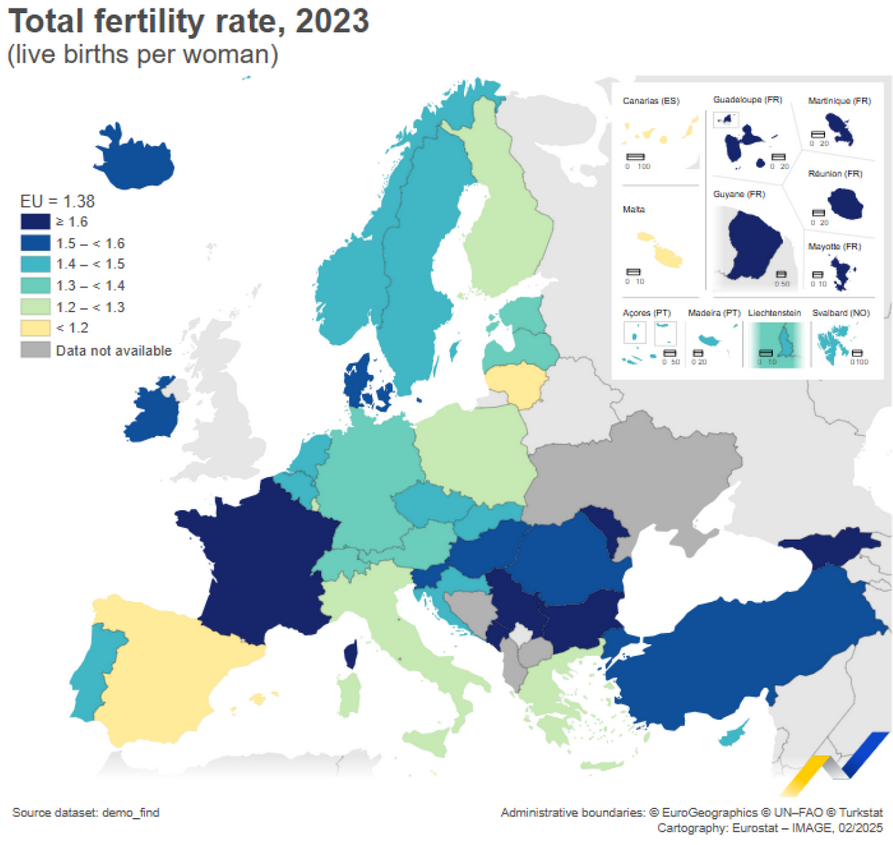Europe‘s population crisis is deepening, with the birth rate hitting a new all-time low. According to Eurostat, just 3.67 million births were recorded in 2023 across the 27 EU countries, a 5.4% drop from 2022. For the first time, 2022 saw births fall below the 4 million mark, while 2023 broke that negative record as well.
The EU’s total fertility rate fell to 1.38 births per woman, the lowest level since 2004, reinforcing fears of a future with an ageing population and severe socio-economic consequences.
Fertility champions and trailblazers
Turning the tables, Bulgaria overtook France to become the country with the highest fertility rate in the EU, reaching 1.81 births per woman. France, which has traditionally had the highest fertility in Europe, dropped to second place with 1.66 births per woman (down from 1.79 in 2022), while Hungary came in third place with 1.55.
On the flip side, countries in the European South continue to record the lowest birth rates. Malta (1.06) and Spain (1.12) are at the bottom, with births steadily declining every year.
Similarly, Greece is experiencing a full blown demographic collapse with 1.26 births per woman with the rate falling every year after being at 1.33 in 2015.

In Italy, under-fertility is also worsening, with the fertility rate falling to 1.21, the lowest level since 1996.
European women are becoming mothers ever more slowly
In addition to declining birth rates, women in Europe are having children at an older age. The average age for first birth in the EU has risen to 29.8 years. Italy has the highest average in Europe, with Italian women having their first child at 31.8 years on average. In contrast, Bulgaria has the youngest mothers, with an average age of 26.9 years for first motherhood.
The population crisis in Europe is shaping a future where an ageing population will put a strain on the pension system, the labour market and social structures.
Greece and Europe are ageing
Population ageing in Europe is accelerating, with Greece recording one of the largest increases in the proportion of older people.
According to the latest Eurostat data, the proportion of people aged 80 and over in the EU has increased by 2.3 percentage points over the past 20 years, reaching 6% in 2023. In Greece, the increase was even greater, as the corresponding rate soared from 3.8% to 7.1%, recording the biggest rise in the EU along with Latvia.
At the same time, the population of people aged 65 and over increased from 16.2% to 21.3%, while the proportion of children under 15 years old fell to 14.9%, confirming the demographic crisis affecting the Old Continent.
During the last twenty years, the average age of the population in the EU has increased significantly, from 39 years in 2003 to 44.5 years in 2023. In Greece, the average age is now 46.5 years, one of the highest in Europe, with Italy (48.4) leading the way.
Portugal and Romania experienced the largest increase in the median age of their population over the period 2003-2023, with an increase of 8.5 and 8.3 years respectively. In contrast, Sweden showed the smallest increase (just 1.1 years), as the country’s birth rate remains at better levels.
Ask me anything
Explore related questions





